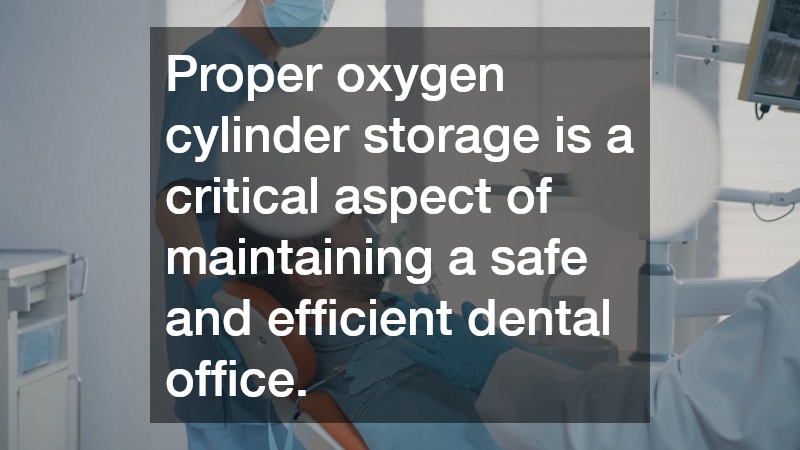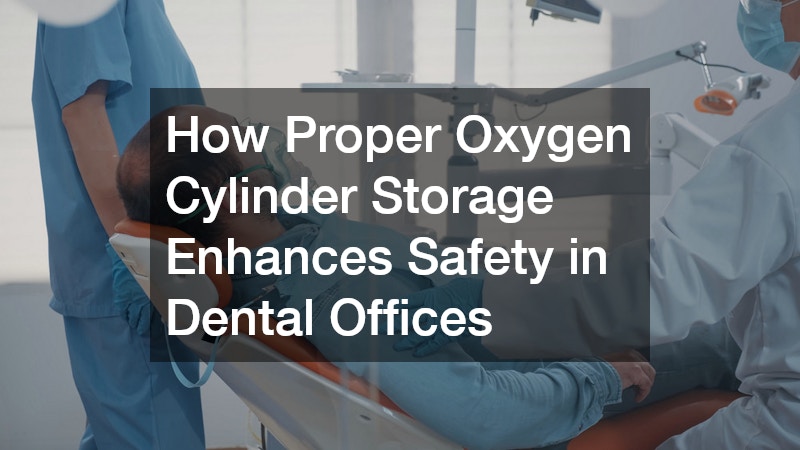
Oxygen is a critical medical gas used frequently in dental offices for various procedures and emergency situations. However, while oxygen cylinders are essential, they also pose significant safety risks if not stored correctly. Proper oxygen cylinder storage is vital to ensure the safety of dental professionals, patients, and the clinic environment. This blog explores why correct storage practices are crucial in dental offices and provides guidelines for maintaining a safe and compliant workspace.
Why Oxygen Cylinder Storage Matters in Dental Offices
Dental clinics often use oxygen cylinders to support patient sedation, manage respiratory emergencies, and assist with certain treatment protocols. Although oxygen itself is non-flammable, it greatly supports combustion, meaning any leaks or improper storage can create hazardous conditions.
An oxygen-enriched environment can increase the risk of fires and explosions, making proper handling and storage essential.
Additionally, oxygen cylinders are pressurized containers that can become dangerous projectiles if damaged or dropped. Mishandling or poor storage can lead to cylinder rupture or leaks, putting both staff and patients at risk. Ensuring that oxygen cylinders are stored securely and according to recommended standards minimizes these hazards and supports an overall culture of safety in dental practices.
Best Practices for Safe Oxygen Cylinder Storage
Dental offices must adopt strict storage protocols to manage oxygen cylinders safely. One of the fundamental steps is selecting a designated storage area that is well-ventilated and free from heat sources or open flames. This space should be secure and restricted to authorized personnel only to prevent accidental interference.
Cylinders must be stored upright and secured using appropriate brackets, chains, or racks to prevent them from falling. It is essential to keep the storage area organized and free of clutter to allow easy access and inspection of the cylinders. Proper labeling of cylinders helps identify their contents quickly and ensures correct usage during treatments.
Moreover, storage locations should comply with local regulations and standards set by organizations such as OSHA (Occupational Safety and Health Administration) or NFPA (National Fire Protection Association). These standards provide guidelines on spacing, signage, and other safety measures critical for maintaining a safe environment.
Handling and Inspection: Key Components of Oxygen Cylinder Safety
Safe oxygen cylinder storage goes hand-in-hand with proper handling and regular inspection. Dental staff should receive training on how to safely move and use cylinders, including the use of cylinder carts or trolleys designed to prevent damage during transport.
Regular inspections are necessary to detect any signs of wear, corrosion, leaks, or damage. Checking valves, regulators, and hoses for integrity ensures that the equipment functions properly and safely. Any defective equipment should be removed from service immediately and repaired or replaced.
Furthermore, dental offices should establish clear protocols for emergency situations involving oxygen cylinders, such as leaks or fires. Staff should be trained on how to respond quickly and effectively, including shutting off oxygen supply and evacuating the area if necessary.
Storage Solutions Tailored for Dental Clinics
Because dental clinics typically operate in smaller spaces than hospitals or industrial settings, customized oxygen cylinder storage solutions are essential. Compact, wall-mounted racks or cabinets designed specifically for medical gases can help maximize space while ensuring secure storage.
These storage units often include ventilation features, locking mechanisms, and clear labeling areas, providing both safety and convenience. Incorporating fire-resistant cabinets for oxygen cylinders adds an extra layer of protection, especially in clinics with limited room for separate storage areas.
Dental offices should also consider easy accessibility in their storage design. Quick access to oxygen cylinders during emergencies can save valuable time and improve patient outcomes. Balancing security with accessibility is key to effective oxygen cylinder management in a dental environment.
Compliance with Regulations and Industry Standards
Dental practices must adhere to stringent regulations regarding oxygen cylinder storage to maintain licensing and avoid legal liabilities. Compliance with OSHA standards ensures that the workplace meets safety requirements concerning medical gases.
The NFPA 99 Health Care Facilities Code provides detailed guidance on medical gas storage, emphasizing proper ventilation, separation from flammable materials, and storage capacity limits. Adhering to these standards not only protects staff and patients but also reduces the risk of costly fines or operational shutdowns.
Regular audits and safety assessments can help dental offices verify compliance and identify areas for improvement. Engaging with professional safety consultants or industry organizations can provide additional support in maintaining best practices.
Prioritizing Safety Through Proper Oxygen Cylinder Storage
Proper oxygen cylinder storage is a critical aspect of maintaining a safe and efficient dental office. Given the potential risks associated with oxygen cylinders, dental professionals must understand and implement best practices for storage, handling, and emergency response.
By designating secure storage areas, using appropriate equipment, adhering to regulatory standards, and training staff effectively, dental clinics can minimize hazards and ensure a safe environment for both patients and personnel. Prioritizing oxygen cylinder storage safety not only protects lives but also enhances the reputation and operational success of dental practices.
Embracing these safety measures reflects a commitment to excellence in patient care and workplace safety, making proper oxygen cylinder storage an indispensable part of any modern dental office.



